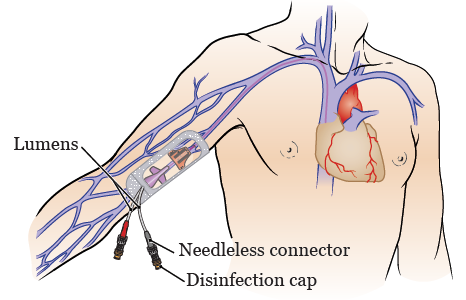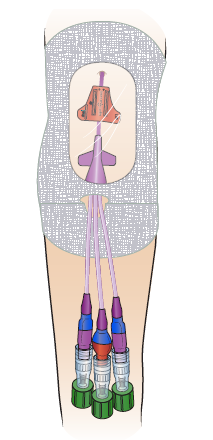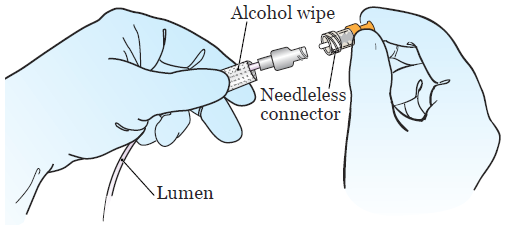Single Lumen Picc Line Blood Draws
This information explains what a PICC is and how it's placed. It also has guidelines for caring for your PICC at home. A PICC is a type of central venous catheter (CVC).
Back to topAbout Your PICC
A PICC, also called a PICC line, is a long, flexible catheter (thin tube) that's put into a vein in your upper arm. There are many different types of PICCs. Your doctor will decide which type is best for you.
All PICCs have 1 end that goes through a vein in your upper arm up to a large vein near your heart. Outside your body, the PICC divides into 1, 2, or 3 smaller tubes called lumens. Each lumen has a needleless connector (also called a clave) and a disinfection cap on the end (see Figure 1).

Figure 1. Parts of your PICC
A PICC can be used to:
- Take blood samples
- Give fluids
- Give chemotherapy and other medications
- Give blood transfusions
- Give intravenous (IV) nutrition
Contrast for a computed tomography (CT) scan can be injected through some PICCs (such as a Bard® Solo Power PICC), but not all types of PICCs.
Having a PICC can help you need fewer needle sticks. A PICC can stay in your body for your entire treatment, up to 18 months. Your doctor will remove it when you don't need it anymore.
Having a PICC shouldn't keep you from doing your normal activities, such as work, school, sexual activity, showering, and mild exercise. Avoid contact sports, such as football and soccer, while your PICC is in place. Ask your doctor or nurse about any activities before you start them.
You'll have a procedure to place your PICC. Your nurse will tell you how to get ready for your procedure. They'll also teach you how to care for your PICC after your procedure. You can have a caregiver, family member, or friend learn with you.
Back to topBefore Your Procedure
Ask about your medications
You might need to stop taking some of your medications before your procedure. Talk with your doctor about which medications are safe for you to stop taking. We've included some common examples below.
Anticoagulants (blood thinners)
If you take a blood thinner (medication that affects the way your blood clots), ask the doctor doing your procedure what to do. Their contact information is listed at the end of this resource. Whether they recommend you stop taking the medication depends on the reason you're taking it.
Do not stop taking your blood thinner medication without talking to your doctor.
| Examples of Blood Thinners | |||
|---|---|---|---|
| apixaban (Eliquis®) | dalteparin (Fragmin®) | meloxicam (Mobic®) | ticagrelor (Brilinta®) |
| aspirin | dipyridamole (Persantine®) | nonsteroidal anti-inflammatory drugs (NSAIDs) such as ibuprofen (Advil®, Motrin®) or naproxen (Aleve®) | tinzaparin (Innohep®) |
| celecoxib (Celebrex®) | edoxaban (Savaysa®) | pentoxifylline (Trental®) | warfarin (Jantoven®, Coumadin®) |
| cilostazol (Pletal®) | enoxaparin (Lovenox®) | prasugrel (Effient®) | |
| clopidogrel (Plavix®) | Fondaparinux (Arixtra®) | rivaroxaban (Xarelto®) | |
| dabigatran (Pradaxa®) | heparin (shot under your skin) | sulfasalazine (Azulfidine®, Sulfazine®) | |
Please read the resource Common Medications Containing Aspirin, Other Nonsteroidal Anti-inflammatory Drugs (NSAIDs), or Vitamin E. It has important information about medications you'll need to avoid before your procedure and what medications you can take instead. You can find it online or ask your healthcare provider for a copy.
Remove devices from your skin
If you wear any of the following devices on your skin, the manufacturer recommends you remove it before your scan or procedure:
- Continuous glucose monitor (CGM)
- Insulin pump
Talk with your healthcare provider about scheduling your appointment closer to the date you need to change your device. Make sure you have an extra device with you to put on after your scan or procedure.
If you're not sure how to manage your glucose while your device is off, talk with the healthcare provider who manages your diabetes care before your appointment.
Tell us if you're sick
If you get sick (such as a fever, cold, sore throat, or the flu) before your procedure, call your doctor's office.
Back to topThe Day of Your Procedure
Things to remember
- Take only the medications your doctor told you to take the morning of your procedure. Take them with a few sips of water.
- Don't apply cream (thick moisturizers) or petroleum jelly (Vaseline®).
What to expect
Once you arrive at the hospital, doctors, nurses, and other staff members will ask you to say and spell your name and date of birth many times. This is for your safety. People with the same or a similar name may be having a procedure on the same day.
Back to topDuring Your Procedure
Your PICC will be put in by a doctor or nurse. First, you'll get a numbing injection (shot) where your PICC will be placed. You won't need general anesthesia (medication to make you sleep).
Once the area is numb, the doctor or nurse will make a small incision (surgical cut) in your upper arm. They'll place the PICC into a vein in your arm and gently move the end of the PICC into a vein near your heart (see Figure 1). They'll use an imaging scan to help them see the catheter while they do this.
Once the PICC is in the right place, the doctor will put a SecurAcath® over the part that's outside your body to keep it from moving (see Figure 2). The SecurAcath will stay in place the whole time you have the PICC. They'll also put a Tegaderm™ dressing over your PICC exit site (the place where it leaves your body) to keep it clean. The Tegaderm dressing will be changed regularly.

Figure 2. PICC with SecurAcath and Tegaderm
After Your Procedure
After your procedure, you'll be monitored until you're ready to move to your hospital room or be discharged from the hospital.
You might have some bleeding and mild discomfort at your catheter exit side. This can last for about 1 to 3 days after your PICC is placed. If you have any bleeding from your exit site, apply pressure and a cold compress to the area. Call your doctor or nurse if the bleeding and discomfort gets worse at any time.
Don't shower for 24 hours after your procedure.
Your emergency kit
Your nurse will give you an emergency kit before your procedure or before you're discharged from the hospital. The emergency kit has:
- 1 toothless clamp
- 1 dressing change kit. The kit includes:
- 2 face masks
- Alcohol-based (Purell®) hand wipe
- Disposable drape
- 2 pairs of nitrile gloves (sterile gloves)
- Chloroprep® applicator
- Alcohol pads
- No Sting swab stick
- 3 needless connectors
- Tegaderm CHG dressing
- Disinfection caps
- Your doctor's office and emergency telephone numbers.
Keep your emergency kit with you at all times. You'll need it if your PICC is leaking, your Tegaderm dressing is damaged or comes off, or your needleless connector or disinfection cap falls off.
Back to topCaring for Your PICC at Home
- Ask your nurse about the best way to secure your catheter.
- Don't put tape over the connection site (where the needleless connector connects to the lumens).
- Check your exit site every day for:
- Redness
- Tenderness
- Leakage
- Swelling
- Bleeding
- Don't have any of the following on the arm where your PICC was placed:
- Needle sticks (such as for blood draws or an IV line)
- Blood pressure measurements
- Tight clothing or tourniquets
- Your Tegaderm dressing, needleless connectors, and disinfection caps will need to be changed and your PICC will need to be flushed at least once a week. It's best if you can come to a Memorial Sloan Kettering (MSK) location so a nurse can care for your PICC. If you can't come to an MSK site, your nurse will help you make other arrangements. Always contact your doctor or nurse if you have any questions.
What to do if your PICC is leaking
- Clamp your PICC line above the leak. Use the clamp in your emergency kit.
- Wipe the area that's leaking with an alcohol pad.
- Call your doctor or nurse right away.
If fluid is leaking while you're getting an infusion, check that the needleless connector is on tightly. If it's still leaking, call your doctor or nurse right away.
If you're getting an infusion at home and fluid is leaking from your exit site, turn off the infusion. Call your doctor or nurse right away.
What to do if your Tegaderm dressing is damaged, loose, or dirty
- Don't take off the damaged, loose, or dirty dressing. Put a new Tegaderm dressing over it.
- Call your doctor or nurse right away.
What to do if your Tegaderm dressing is wet
- Don't take off the wet Tegaderm dressing. Don't put another dressing over it.
- Call your doctor or nurse right away.
What to do if your disinfection cap falls off
Throw the disinfection cap that fell off in the trash. Don't put it back on the lumen.
To put on a new disinfection cap:
- Clean your hands with soap and water or an alcohol-based hand sanitizer.
- Get a new disinfection cap from your emergency kit. Remove the cap from the strip.
- Hold the needleless connector in one hand. With your other hand, gently push and twist the new disinfection cap onto the end of the needleless connector.
What to do if your needleless connector falls off
Throw the needleless connector that fell off in the trash. Don't put it back on the lumen.
To put on a new needleless connector:
- Gather your supplies. You'll need:
- 1 pair of nonsterile gloves
- 2 alcohol pads
- 1 new needleless connector
- 1 new disinfection cap
- Clean your hands with soap and water or an alcohol-based hand sanitizer. Put the gloves on.
- Get your supplies ready.
- Open 1 of the alcohol pad packets, but leave the alcohol pad inside.
- Open the needleless connector packet, but leave the needleless connector inside.
- Pull the tab to take the cover off the disinfection cap, but leave the disinfection cap inside its plastic holder.
- Open the other alcohol pad packet. Using the alcohol pad inside, pick up the lumen with your nondominant hand (the hand you don't write with). Hold it close to the end (see Figure 3).

Figure 3. Twisting on the new needleless connector
- Pick up the other, open alcohol pad with your dominant hand (the hand you write with). Scrub the open end of the lumen with the alcohol pad for 15 seconds, then throw the alcohol pad in the trash. Let the lumen dry for 15 seconds. Keep holding it with the alcohol pad in your nondominant hand.
- Pick up the new needleless connector with your free hand. If it has a cover, take the cover off. You can do this using the knuckles of your other hand. Then, twist the new needleless connector onto the end of the lumen (see Figure 3). Keep holding the lumen with the alcohol pad in your nondominant hand.
- Pick up the plastic holder with the disinfection cap with your free hand. Gently push and twist the disinfection cap onto the end of the needleless connector. Once it's attached, pull off the plastic holder and throw it away.
- Take your gloves off. Clean your hands.
Call your doctor or nurse after you change the needleless connector.
Back to topGuidelines for Showering
Follow the instructions in this section when you shower. Don't submerge your PICC in water (such as in a bathtub or swimming pool).
For more information about showering with a PICC, watch Showering While You Have a Central Venous Catheter (CVC).
Use a waterproof cover
You can shower with your PICC in place using a one-time-use waterproof cover (such as Aquaguard®) that goes over your dressing to keep it from getting wet. You can buy waterproof covers online.
Each time you shower, cover your Tegaderm dressing completely with a new waterproof cover. To put on the cover:
- Peel off the top and side strips.
- Place the top edge above your dressing. Don't let the tape on the waterproof cover touch your Tegaderm dressing. It can lift your dressing when you remove the waterproof cover after showering. Smooth the cover down over your dressing.
- Peel off the bottom strip. Make sure the bottom edge of the waterproof cover is below your dressing and the lumens of your PICC are tucked into the waterproof cover and completely covered. Smooth the bottom edge down.
Don't shower for longer than 15 minutes. Use warm water, not hot water. This will help keep the waterproof cover from coming off.
After your shower, dry the waterproof cover before removing it.
Use a 4% chlorhexidine gluconate (CHG) solution antiseptic skin cleanser (such as Hibiclens®)
While your PICC is in place, it's very important to keep your skin clean to lower your risk of infection. Wash with a 4% CHG solution antiseptic skin cleanser every day while your PICC is in place.
An antiseptic is something that kills bacteria and other germs. 4% CHG solution is an antiseptic that kills germs for up to 24 hours after you use it. Showering with a 4% CHG solution will help lower your risk of infection.
You can buy a 4% CHG solution antiseptic skin cleanser from any local pharmacy or online. A staff member will also give you a small bottle when you're discharged from the hospital.
Instructions for using a 4% CHG solution antiseptic skin cleanser
- Use your normal shampoo to wash your hair. Rinse your head well.
- Use your normal soap to wash your face and genital area. Rinse your body well with warm water.
- Open the 4% CHG solution bottle. Pour some into your hand or a clean washcloth.
- Move away from the shower stream. Rub the 4% CHG solution gently over your body from your neck to your feet. Don't put it on your face or genital area.
- Move back into the shower stream to rinse off the 4% CHG solution. Use warm water.
- Dry yourself off with a clean towel after your shower.
- Don't put on any lotion, cream, deodorant, makeup, powder, perfume, or cologne after your shower.
Important points to remember when using 4% CHG solution
- Don't use regular soap, lotion, cream, powder, or deodorant without talking with your nurse first. If you're in the hospital, your nurse might give you a lotion that you can use after using 4% CHG solution.
- Don't use 4% CHG solution on your head, face, ears, eyes, mouth, genital area, or on deep wounds. If you have a wound and aren't sure if you should use 4% CHG solution on it, ask your doctor or nurse.
- Don't use 4% CHG solution if you're allergic to chlorhexidine.
- If your skin gets irritated or you have an allergic reaction when using 4% CHG solution, stop using it and call your doctor.
When to Call Your Healthcare Provider
Call your healthcare provider right away if:
- You pull your PICC line out of place or think you might have pulled it out of place.
- You have a fever of 100.4 °F (38 °C) or higher.
- You have shortness of breath.
- You feel lightheaded or dizzy.
- You have nausea (feeling like you're going to throw up) or vomiting (throwing up).
- You feel confused.
- You have discomfort in your chest.
- You have swelling in your hand, fingers, upper arm, or neck.
- You have aching in the arm where your PICC is placed.
- You have heart palpitations (a faster heartbeat than usual).
- You have numbness or tingling in your arm, hands, or fingers of the arm where the PICC line is placed.
- You have bleeding from the PICC line site.
- You have redness or warmth at the PICC line site or in the arm with the PICC line.
- Your PICC line is leaking.
Single Lumen Picc Line Blood Draws
Source: https://www.mskcc.org/cancer-care/patient-education/about-your-peripherally-inserted-central-catheter-picc
0 Response to "Single Lumen Picc Line Blood Draws"
Post a Comment